Normal walking or running patterns are divided into a number of phases. There is a Stance + Swing Phase for each leg during each walking or running cycle. Walking or running speed is determined by the number of cycles x stride length. There are minor differences between walking and running but mostly in terms of timing, speed and magnitude of force used
Stance phase occurs when the leg is in contact with the ground and is subdivided into
- Foot Landing,
- Midstance and
- Toe Off / Propulsion phases.
Swing phase occurs when the leg is off the ground and is divided into
- Follow Through,
- Forward Swing and
- Foot Descent.
The relative duration of stance and swing phase varies significantly depending on the activity and speed. During walking there is always one foot on the ground. The Stance Phase in walking is longer than Swing Phase.
A longer Stance Phase is associated with increased resistance to forward locomotion. During running the time in contact with the ground is reduced and the swing phase is lengthened, thus reducing resistance to forward movement.
Key movements occur at the ankle + foot during stance phase in order for walking to be efficient. During Foot Landing on weightbearing the foot can behave in a variety of ways.
Typically there is heel strike followed by placing the foot flat on the floor before raising the heel leading to toe off.
During running where the speed is greater the foot may land relatively flat with less time to heel raise + toe off.
At high speeds the foot remains pointing toe down and only the forefoot makes contact with the ground.
Variation from the normal movement during walking or running is often associated with alteration in the biomechanics, raising the risk of injury. These may include excessive pronation, excessive supination or altered pelvic postures / movements.
These variations from normal movement affect the whole kinetic chain throughout the body. Secondary ‘compensatory’ postures or movement can then arise - further increasing the risk of injury.
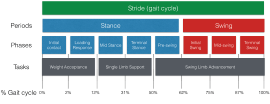
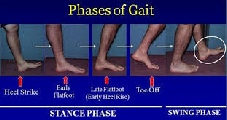
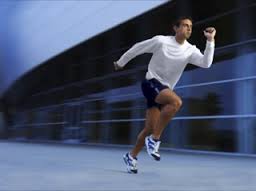
Running is a fundamental skill of many sporting activities. Straight line running is as a key part of basic fitness training and fitness programmes, even for sports that primarily use multidirectional running skills. Efficient running mechanics will maximise performance and minimise the risk of injury.
Many overuse / overloading injuries occur while running.
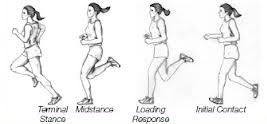
Efficient Running requires:.
Body alignment and good posture (form)
- The body segments in good alignment when weightbearing in stance phase.
- The body should not be flexed in the middle at the hip
- The centre of gravity over the arch of the foot when the weight is on the foot during midstance. If the foot lands ahead of it there is ‘over-striding’. This has a braking effect on movement
- When running the feet land closer to the midline, but not crossing the midline.
- The legs / toes point directly forward as speed increases
- Ankle/big toe flexibility should allow a forward lean of the body when in stance phase on the leg with the foot pointing forward.
- The arms should drive back and forth from the shoulders and counterbalance the movements of the opposite leg
- The elbows are bent and the hands should not come across the midline of the body in front
- The legs should move back and forth from the hips with the feet moving parallel to each other and the foot pointing forward
- The pelvis should be kept level, or neutral, when viewed from in front or from the side and not dip on the swing side
- Minimal head and trunk moving up / down or sideways The foot should not land in front of the hip (‘over- striding’). This has a ‘braking’ effect on the body and slows forward speed. It causes ‘Pawback’ or overload the hamstrings

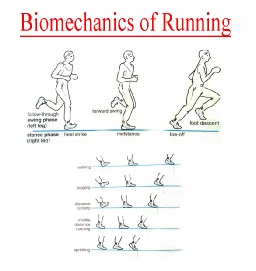
There may be overuse of muscles during running
Excessive pulling the foot and toes upwards to get heel strike can cause extensor tendonitis.
Excessive running on the forefoot / ball of the foot may strain the Achilles tendon and the deep flexor muscles – causing shin splints.
The hip on the swing phase side should not be allowed to dip/drop down excessively - It indicated weakness on the weightbearing side and is inefficient
During walking there is always one foot in contact with the ground. When running stance phase is reduced and the swing phase is lengthened. The Swing Phase may be long enough that both feet are off the ground simultaneously- ‘Flight Phase’. The longer the flight phase is the less energy is used
Key factors in determining the length of Flight Phase are:
- Leg lift
- Knee bend
- Follow through
- Knee drive
- Knee lift Forward swing


By maximising Flight Phase you minimise the slowing effect of contact with the ground and run most efficiently.
However with the time of contact reduced the forces to be exerted by the muscles are increased. Therefore they must work more powerfully and vigorously – hence sprinters need to be powerful and very strong Back to Top
The muscles must be activated in a precise order. The normal sequence of activation for the posterior kinetic chain muscles is
- gluts
- Hamstrings
- spinal muscles of the opposite side
- spinal muscles of the same side.
The pattern of neuromuscular activation and motor control of movement will typically show balance between the muscles of the front and back of the body and between either sides.
Muscle weakness, disuse, muscle imbalances, loss of flexibility will all have a negative impact.
The following Video describes some drills which facilitate developing a good running technique
Barefoot running can be beneficial but should only be done in very small amounts over short periods and should be progressed very slowly if at all.
It may be appropriate to have a detailed biomechanical assessment carried out by a physiotherapist or a podiatrist.
Simple corrective measures may be sufficient to solve a problem. Bad running technique may be corrected by an athletics coach.
For detailed assessment, further information or advice please contact the clinic directly. To Top
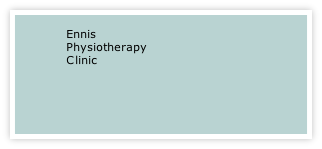




Mon - Fri 9.30am - 8.30pm


3A Barrack Close, Barrack St., Ennis, Co. Clare V95 X437

065 6840757
| Health+Safety Services |
| Sports Clubs+Teams Services |
| Standing Posture |
| Sitting Posture |
| Childhood Posture |
| Using Portable Devices |
| Normal Walking |
| Running |
| Running Drills Videos |
| Muscle Energetics |
| General Fitness |
| Losing Body Weight |
| Gaining Body Weight |
| Weight Loss Programmes |
| Start to Run |
| Start to Swim |
| Start Cycling |
| Start Nordic Waliking |
| Rehab of Tensdons |
| Loading of Tendons |
| Non Specific LBP |
| Posture |
| Intervertebral Disc |
| LBP Treatment |
| Non Specific Neck Pain |
| Neck Care Advice |
| Hamstring Strain |
| Ankle Sprain |
| ACL Injury |
| Joint Replacement |
| Shoulder Dislocation |
| Tennis Elbow |
| Wrist fracture |
| Fractured Knuckle |
| Selecting a Racquet |
| Racquet Grip Size |
| Racuet Sport Injuries |
| Training for Racquet Sports |
| Ski + Board Injuries |
| Injury Videos |
| Injury Prevention |
| Preventing Injury in Musicians |
| Irish Dancing |
| Preventing Dance Injury |